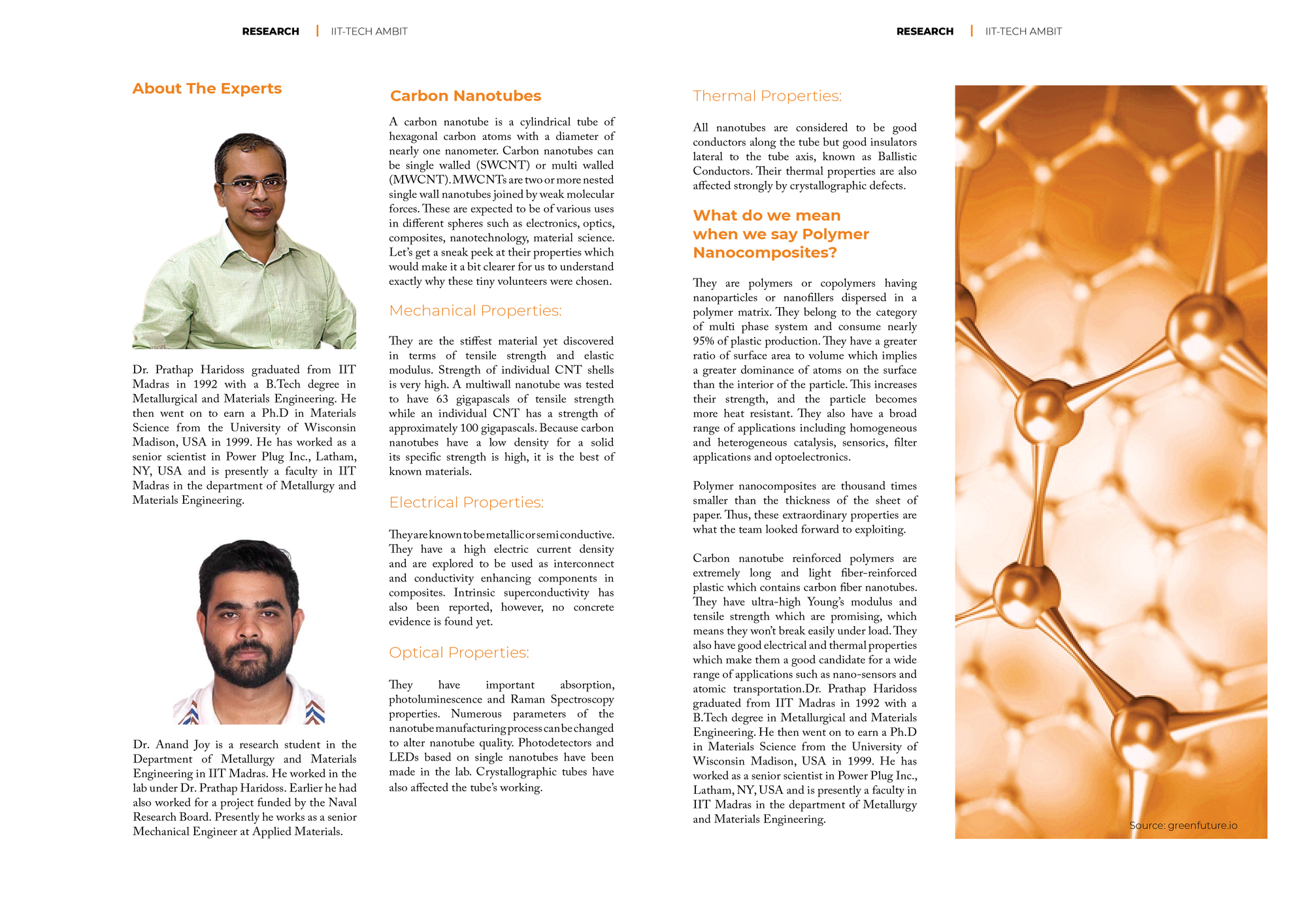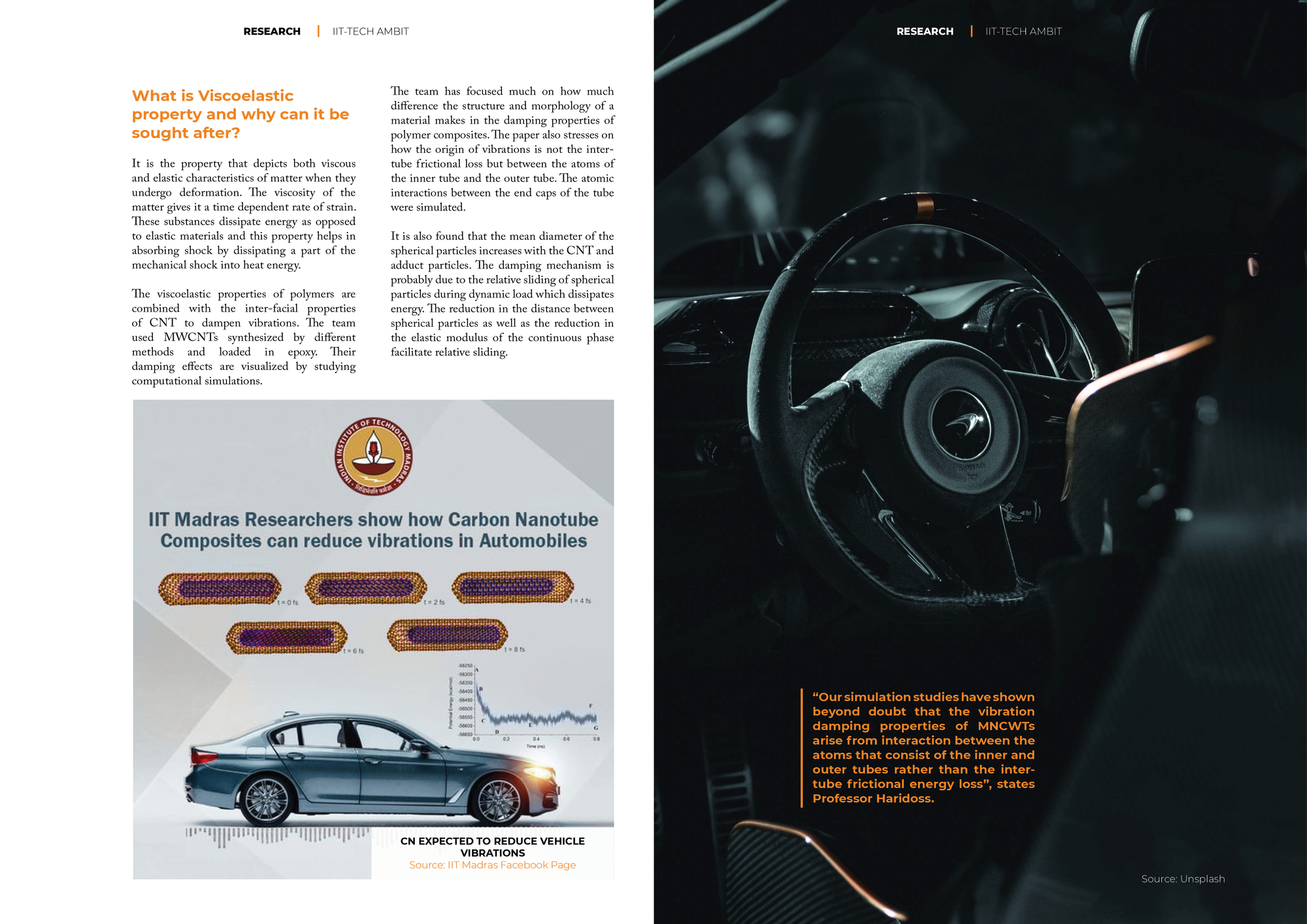“While it may seem small, the ripple effect of small things is extraordinary”
For centuries, it was small things that had a much humongous effect on mankind as compared to the bigger things. For instance, a small depreciation in a country’s currency can result in a big economic setback, a small virus can cause a pandemic and so on. However, small things can also bring about significant positive changes. It has been discovered that a small element called “nanofibre” can have a great impact on our lifestyle. But how? Let us take a look at the latest innovation by a team from IIT Madras.
Dr. Prathap Haridoss, Dr. Anand Joy, Dr. Susy Varughese, Dr. Anand K. Kanjarla, Dr. S. Sankaran along with the research students from the Metallurgy and Materials Department of IIT Madras has come up with Carbon Nanotube Composites that can reduce vibrations in automobiles. Their paper has been published in the peer reviewed international journal Nanoscale Advances. They have together developed an interesting polymer based composite. It shows how carbon nanotube fibres can help reduce vibrations.

About The Experts

Dr. Prathap Haridoss graduated from IIT Madras in 1992 with a B.Tech degree in Metallurgical and Materials Engineering. He then went on to earn a Ph.D in Materials Science from the University of Wisconsin Madison, USA in 1999. He has worked as a senior scientist in Power Plug Inc., Latham, NY, USA and is presently a faculty in IIT Madras in the department of Metallurgy and Materials Engineering.

Dr. Anand Joy is a research student in the Department of Metallurgy and Materials Engineering in IIT Madras. He worked in the lab under Dr. Prathap Haridoss. Earlier he had also worked for a project funded by the Naval Research Board. Presently he works as a senior Mechanical Engineer at Applied Materials.
Carbon Nanotubes:
A carbon nanotube is a cylindrical tube of hexagonal carbon atoms with a diameter of nearly one nanometer. Carbon nanotubes can be single walled (SWCNT) or multi walled (MWCNT). MWCNTs are two or more nested single wall nanotubes joined by weak molecular forces. These are expected to be of various uses in different spheres such as electronics, optics, composites, nanotechnology, material science. Let's get a sneak peek at their properties which would make it a bit clearer for us to understand exactly why these tiny volunteers were chosen.
Mechanical properties- They are the stiffest material yet discovered in terms of tensile strength and elastic modulus. Strength of individual CNT shells is very high. A multiwall nanotube was tested to have 63 gigapascals of tensile strength while an individual CNT has a strength of approximately 100 gigapascals. Because carbon nanotubes have a low density for a solid its specific strength is high, it is the best of known materials.
Electrical properties- They are known to be metallic or semi conductive. They have a high electric current density and are explored to be used as interconnect and conductivity enhancing components in composites. Intrinsic superconductivity has also been reported, however, no concrete evidence is found yet.
Optical properties- They have important absorption, photoluminescence and Raman Spectroscopy properties. Numerous parameters of the nanotube manufacturing process can be changed to alter nanotube quality. Photodetectors and LEDs based on single nanotubes have been made in the lab. Crystallographic tubes have also affected the tube’s working.
Thermal properties- All nanotubes are considered to be good conductors along the tube but good insulators lateral to the tube axis, known as Ballistic Conductors. Their thermal properties are also affected strongly by crystallographic defects.

What do we mean when we say Polymer Nanocomposites?
They are polymers or copolymers having nanoparticles or nanofillers dispersed in a polymer matrix. They belong to the category of multi phase system and consume nearly 95% of plastic production. They have a greater ratio of surface area to volume which implies a greater dominance of atoms on the surface than the interior of the particle. This increases their strength, and the particle becomes more heat resistant. They also have a broad range of applications including homogeneous and heterogeneous catalysis, sensorics, filter applications and optoelectronics.
Polymer nanocomposites are thousand times smaller than the thickness of the sheet of paper. Thus, these extraordinary properties are what the team looked forward to exploiting.
Carbon nanotube reinforced polymers are extremely long and light fiber-reinforced plastic which contains carbon fiber nanotubes. They have ultra-high Young’s modulus and tensile strength which are promising, which means they won’t break easily under load. They also have good electrical and thermal properties which make them a good candidate for a wide range of applications such as nano-sensors and atomic transportation.


What is Viscoelastic property and why can it be sought after?
It is the property that depicts both viscous and elastic characteristics of matter when they undergo deformation. The viscosity of the matter gives it a time dependent rate of strain. These substances dissipate energy as opposed to elastic materials and this property helps in absorbing shock by dissipating a part of the mechanical shock into heat energy.
The viscoelastic properties of polymers are combined with the inter-facial properties of CNT to dampen vibrations. The team used MWCNTs synthesized by different methods and loaded in epoxy. Their damping effects are visualized by studying computational simulations.
“Our simulation studies have shown beyond doubt that the vibration damping properties of MNCWTs arise from interaction between the atoms that consist of the inner and outer tubes rather than the inter-tube frictional energy loss”, states Professor Haridoss.
The team has focused much on how much difference the structure and morphology of a material makes in the damping properties of polymer composites. The paper also stresses on how the origin of vibrations is not the inter-tube frictional loss but between the atoms of the inner tube and the outer tube. The atomic interactions between the end caps of the tube were simulated.
It is also found that the mean diameter of the spherical particles increases with the CNT and adduct particles. The damping mechanism is probably due to the relative sliding of spherical particles during dynamic load which dissipates energy. The reduction in the distance between spherical particles as well as the reduction in the elastic modulus of the continuous phase facilitate relative sliding.
So, as we can guess, our car rides shall be much smoother in near future as these tiny technicians shall dampen the vibrations relentlessly and maybe soon we can see a greater revolution in the composites world that may not only bring about changes in automobile industry but also in many other spheres!



